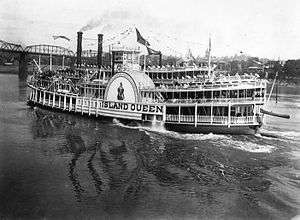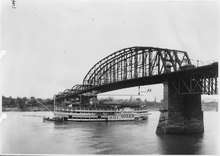Island Queen
The Island Queen was a series of two American sidewheeler steamboats built in 1896 and 1925 respectively. Both vessels were passenger carriers cruising along the Mississippi and Ohio rivers as both an excursion boat and tramp steamer . The first Island Queen burned in 1922 in a fire which destroyed several other vessels. The second Island Queen was destroyed in 1947 when its Chief Engineer, using a welding torch, accidentally cut into her fuel tank. The Island Queen was reduced to its steel frame. The boat was scrapped by a local company.
 The first Island Queen in Cincinnati, Ohio in 1896 | |
| History | |
|---|---|
| Name: | Island Queen (first iteration) |
| Owner: | Lee H. Brooks, Coney Island Company |
| Operator: | Sterling McIntyre, James DuPuy |
| Route: | Ohio River, Mississippi River, Cincinnati to Coney Island |
| Builder: | Cincinnati Marine Railway Co. |
| Launched: | May 16, 1896 |
| In service: | 1896 |
| Out of service: | April 27, 1922 |
| Fate: | Severe structural damage sustained by fire |
| Status: | Presumably scrapped |
| General characteristics | |
| Type: | Paddle steamer |
| Length: | 281.4 ft (85.8 m) |
| Beam: | 42.6 ft (13.0 m) |
| Depth of hold: | 8.5 ft (2.6 m) |
| Decks: | 3 cabin deck |
| Propulsion: | Compound non-condensing steam engines, 20's, 35', 9 ft reach. Six boilers, 42x24 ft. Side-mounted paddlewheel |
| Capacity: | Presumably about 4,100 passengers |
First Island Queen
| Wikimedia Commons has media related to Island Queen (ship, 1896). |
The first Island Queen was a sidewheel excursion wooden hull steamboat built in Cincinnati, Ohio in 1896. She was owned by Coney Island Company and used to ferry passengers between Cincinnati and Coney Island amusement park. She was christened May 16, 1896 by the daughter of Lee H Brooks, Coney Island Company's chairman.[1]
In off-seasons when the park was closed she operated as a tramp steamer on the Mississippi and Ohio rivers, going as far downstream as New Orleans. On April 27, 1922 her forward hurricane deck collapsed, injuring 27 children and paralyzing one. That same year on November 4, Island Queen was severely burned and decommissioned after a fire engulfed several steamboats in Cincinnati harbor.[2]
.jpg)
Second Island Queen
| Wikimedia Commons has media related to Island Queen (ship, 1925). |
The second Island Queen was built in parts beginning in 1923. Midland Barge Company of Midland, Pennsylvania built its steel hull, designed as a matched pair with the Cincinnati for the Louisville & Cincinnati Packet Company and John W. Hubbard. After taking delivery on the hull and naming it Louisville, the owner instead resold it to the Coney Island Company.[3] Coney Island Company finished the boat in Cincinnati on April 18, 1925.[4] The new Island Queen measured 285-feet long and could carry 4,000 people. The 1000-ton sidewheeler was powered by oil-burning steam engines with six boilers. It was fully completed and christened in Cincinnati by the Coney Island Company on April 18, 1925.[5]
Like her predecessor, Island Queen was used for excursions to Coney Island amusement park and tramping between New Orleans, and as far upstream as Pittsburgh, Pennsylvania.
Coney Island Company hired musicians to entertain the passengers. Sidney Desvigne, a cornet player from New Orleans, recruited musicians from his hometown to perform on excursions for the Cincinnati market. In 1929, his band included Henry Julian, Ransom Knowling, Walter "Fats" Pinchon, Percy Servier, and Gene Ware.[6]
While in Pittsburgh, on September 9, 1947, her chief engineer struck her fuel tank with a welding torch, causing a fire and a series of explosions that eventually reduced Island Queen to her steel structure, and killed 19 crew. No passengers were aboard at the time of the fire, but about 40 members of the crew were aboard.[5] Force from the explosions could be felt throughout downtown Pittsburgh, shattering windows in nearby buildings. There were even reports of people being knocked down on streets close to the dock.[7]

.jpg)
References
- "Coney Island Company led by Commodore Lee Brooks". Archived from the original on 2015-10-09.
- Way Jr., Frederick (1983). Way's Packet Directory, 1848-1994. Ohio University Press. pp. 228–229. ISBN 0-8214-1106-3.
- Frederick Way Jr. (1994). Way's Packet Directory, 1848–1994. Athens, OH: Ohio University Press. pp. 87–88.
- Way (1994), p. 228.
- "Island Queen". Coney Island Central. Retrieved 5 November 2017.
- "Desvigne's Bandsmen on the S.S. Island Queen". Riverboats & Jazz. Tulane University. Retrieved 4 November 2017.
- "Tragic explosion on excursion steamer Island Queen". Pittsburgh Post-Gazette. 28 January 2013. Retrieved 5 November 2017.
External links
- Island Queen steamboat The Public Library of Cincinnati and Hamilton County.
- Island Queen (steamboat) Indiana Memory Digital Collections.